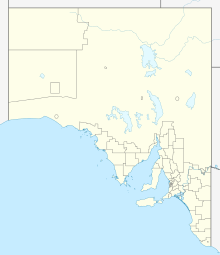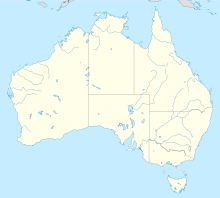Telford Cut facts for kids
| Location | |
|---|---|
| Location | Leigh Creek |
| State | South Australia |
| Country | Australia |
| Coordinates | 30°29′00″S 138°25′00″E / 30.48333°S 138.41667°E |
| Production | |
| Products | sub-bituminous coal |
| History | |
| Opened | 1943 |
| Closed | 2015 |
| Owner | |
| Company |
|
The Telford Cut was a large open-cut coal mine in the Leigh Creek Coalfield in South Australia. It operated for 72 years, from 1943 until it closed in 2015. This mine provided a type of coal called sub-bituminous coal. This coal was used to power electricity stations, first in Adelaide and later in Port Augusta. Even after mining stopped in November 2015, coal that was already dug up was still sent to Port Augusta until the last power station there closed in May 2016.
Contents
Digging for Coal: The Telford Cut Mine
The Telford Cut was an open-cut mine. This means coal was dug up from the surface of the earth, like a giant hole. The mine extracted a type of coal known as low-grade sub-bituminous coal. This coal was then sent 250 kilometers by train to power stations near Port Augusta.
The coal at Leigh Creek was found in several layers, like bowls stacked inside each other. Each layer was several meters thick. The mine was first run by the Electricity Trust of South Australia (ETSA). Later, it was operated by Alinta Energy. The mine produced over 2.5 million tonnes of coal each year. Alinta Energy also ran the power stations in Port Augusta. These were the last power stations in South Australia that used coal.
Finding the Coal: Early Discoveries
In 1888, a man named John Henry Reid found coal-like rock while digging a railway dam in the Leigh Creek area. A government geologist, Henry Brown, confirmed this discovery in 1889. This led to more studies of the area and some underground digging.
An early company, the Leigh Creek Coal Mining Company, tried to dig a shaft. But they hit a lot of water and had to stop. Another shaft was dug in 1892, but only small amounts of coal were taken out for tests. Operations stopped in 1894.
Starting the Mine: A New Beginning
The coal at Leigh Creek became important again in 1940. This was during the Second World War, when coal supplies were very low. People realized there was a lot of coal at Leigh Creek. They thought it could be dug up using open-cut methods.
Testing began in 1941, and plans were made for the first open-cut mine. Digging started in 1943. The Electricity Trust of South Australia (ETSA) took over the mine in 1948. This was because the electricity industry would be the main user of the coal.
ETSA ordered special boilers for the Osborne Power Station near Port Adelaide that could burn Leigh Creek coal. They also decided to build a new power station in Port Augusta just for this coal. The Playford A Power Station was built in the 1950s, followed by Playford B Power Station in the 1960s. These power stations were named after the Premier of South Australia at the time, Sir Thomas Playford.
Large digging machines and good mining equipment were used at Leigh Creek. Also, a railway line was rebuilt between Leigh Creek and Port Augusta. This made it cheaper and easier to get the coal to the power stations.
Growing the Mine: More Power, New Town
In the mid-1970s, a bigger power station was planned for Port Augusta. It was called the Northern Power Station. This meant the coalfield had to get much larger. New ways were used to dig deeper for coal, and production increased. A dam was built to stop floods, and the main highway was moved around the coalfield. The Northern Power Station started working in 1985.
Because the old town of Leigh Creek was in the way of the expanding mine, a new town was built south of the coalfield. People moved into the new Leigh Creek in 1980.
Over time, the mining operations changed a lot. The number of workers went down from over 750 to about 200. The town also became smaller.
Moving the Coal: Rail Transport
The coal was first moved by a narrow gauge railway called the Central Australia Railway. This railway went through the Flinders Ranges. But this old railway was not built for heavy, frequent coal trains.
Instead of upgrading the old line, a new, heavier standard-gauge railway was built. This new line, called the Marree railway line, opened in May 1956. It connected the mine to Port Augusta. This new railway made it much easier to transport the large amounts of coal needed for the power stations.
In 1987, the end of the Marree line was moved closer to the Telford Cut mine. A special loop was built to make it easier for trains to turn around. The railway stopped running after the power station closed in May 2016.
Closing Down the Mine
On June 11, 2015, Alinta Energy announced that they planned to close the Leigh Creek coal mine. They also planned to close the related Playford B and Northern power stations.
On July 30, 2015, Alinta Energy said that the closure dates for all three places would be moved up by 12 months. This meant they might close as early as March 2016. The power stations in Port Augusta eventually closed on May 8, 2016.
It was confirmed on October 7, 2015, that mining at Telford Cut would stop on November 17, 2015. After that date, coal that was already dug up was sent by train to Port Augusta until the power station closed.
Cleaning Up the Mine Site
After the mine closed, Alinta Energy had to clean up the site. This is called remediation. One important task was to make sure that any remaining coal could not catch fire on its own. They did this by making the steep sides of the mine less steep. They also covered any coal with at least two meters of clean earth.
Future Plans for the Site
After the mine closed, there was a plan to use the site for something called underground coal gasification. This is a process that turns coal into gas while it's still underground. However, the local Adnyamathanha community is against this project.
The Town of Leigh Creek
The nearby town of Leigh Creek was home to many of the mine workers and their families while the mine was operating.



